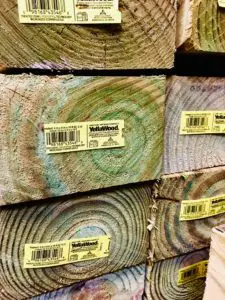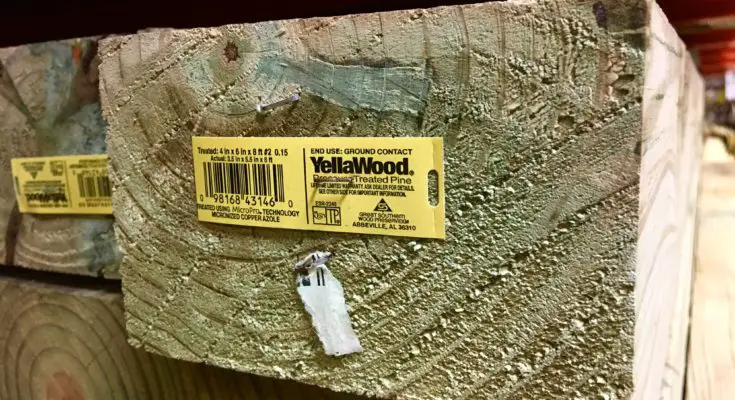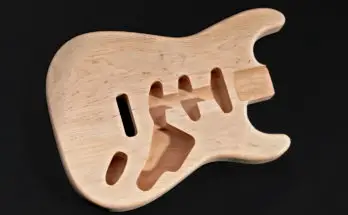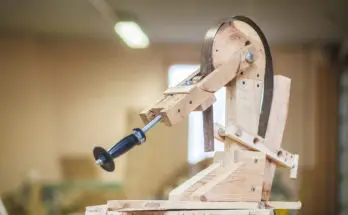Using pressure treated lumber indoors is a subject of great debate among wood experts. While many woodworkers strongly object to the use of pressure treated lumber inside a home, there are others who say that the use of pressure treated lumber indoors is perfectly safe. For those who are not experts, this controversy can leave many people confused and unsure what to do.
Why is Wood Pressure Treated?
A quick stroll down the lumber aisle at your local big box store and you’ll see that their wood is probably separated into two sections – pressure treated and non-treated wood. The pressure treated wood is easy to spot because it typically has a greenish tint that you’ll notice in some of the photos on this page.
Wood began being pressure treated with chemicals in the early 1900’s as a means for preserving wood that is used outdoors. Lumber companies discovered that by forcing certain chemicals into their woods, they could prolong the life of the wood when exposed to wet conditions that are often present outdoors. They also found that these chemicals prevented insects, especially termites, from invading and destroying the wood.
The process of pressure treated wood and the chemicals used have evolved significantly over the past century. However, there are still dangers present when dealing with the chemicals used to protect the wood we use outdoors.
The Dangers
There have been homeowners who have been known to use recycled wood materials from telephone poles and cross ties inside the home. Many believe this to be of great danger to those who reside in such a home because most houses are sealed tightly to maintain energy efficiency. The levels of chemicals from the recycled wood could be raised to dangerous proportions inside a tightly sealed home. As a result, residents inside could suffer from negative respiratory effects.
 Some of the chemicals that have been sprayed on outdoor wood are creosote which contains phenols, cresols, and polycyclic aromatic hydrocarbons. These chemicals were not meant to be used indoors.
Some of the chemicals that have been sprayed on outdoor wood are creosote which contains phenols, cresols, and polycyclic aromatic hydrocarbons. These chemicals were not meant to be used indoors.
Not only could they cause respiratory illnesses, but they could contribute to other health issues as well. Some of the other negative effects of these chemicals are skin reactions, eye irritation, and even cancer.
Various levels of toxicity present a danger depending on what was used to treat the wood. Any type of poison can be hidden if it has been diluted. If some types of pressure treated wood happen to have direct contact with a person’s bare skin, there is a danger of poison seeping through the pores.
Having food around pressure treated wood is another major concern. Cutting boards made from pressure treated wood could present a problem. There is a chance that any chemicals on the wood could get into any food that has contact with the cutting board. Once ingested, it could cause serious digestive issues.
Due to the types of chemicals in pressure treated wood, it is highly flammable. Depending upon the use indoors, that factor could present a danger. If there was a small fire that started indoor, it could easily erupt into an out of control blaze when fire reaches any pressure treated wood inside the home.
Newer Pressure Treated Lumber
When pressure treated lumber was first patented in 1938, the preservative that was used Chromated Copper Arsenate which is arsenic based. Since then it has been replaced with another preservative that is copper based. Although it is not as dangerous as the arsenic based preservative, there is a risk for cancer with the copper-based type.
The Canadian government is very cautious concerning pressure treated lumber. Many wood experts in Canada adamantly refuse to use pressure treated wood indoors as they believe the chemicals will eventually come out of the wood as it ages. They will not advise anyone to use it indoors. However, many experts tell homeowners to avoid using it on cutting boards or any place where it would be in contact with food if homeowners are going to use pressure treated lumber inside their homes.
Many people use pressure treated lumber to build bedframes and dining room tables. A great deal of controversy erupts on many question and answer websites over these issues. Woodworkers advise people not to use pressure treated wood for a dining room table as they, like others, believe the chemicals will eventually come through the wood. Wood experts say using bed frames made from pressure treated lumber is not safe either.
Why Many Defend Indoor Use
The Environmental Protection Agency approved the newer types of pressure treated wood for indoor use. Some experts claim that you can use the new pressure treated wood the same way that you would use untreated wood. Borate wood is now being used. Many believe this type is safe because it is a trace mineral found in water, rocks, and soil.
 Borate is said to be essential to plant life, colorless, odorless, and it penetrates deep into the wood. It can be used for most indoor purposed except cutting boards. Some indoor projects for which borate treated wood is used are interior trim, studs, sill plates, joist, rafters, and trusses.
Borate is said to be essential to plant life, colorless, odorless, and it penetrates deep into the wood. It can be used for most indoor purposed except cutting boards. Some indoor projects for which borate treated wood is used are interior trim, studs, sill plates, joist, rafters, and trusses.
When a worker cuts pressure treated wood, the worker must wear protective clothing. Cutting some lumber requires the wearing of a mask. If protective clothing is required to wear while working around this type of lumber, many argue that it is too dangerous to be left indoors.
Pressure treated borate plywood can be used anywhere that moisture may be present. Bathrooms and laundry rooms are common room in which you can use borate plywood. It can also be used for exterior sheathing.
Yellow pine and Douglas fir are the types of wood treated with borate. Sometimes hemlock, western pine, and spruce are treated with borate, but Douglas fir and yellow pine are the most common. If you are interested in attempting to use pressure treated lumber indoors, these types might be worth considering.
Further Controversy
On a popular website, the question was raised concerning pressure treated wood being used in a basement. A homeowner was concerned about the wood containing arsenic and wondered if the chemical could eventually seep from the wood. One expert said that the truly dangerous factor of the pressure treated lumber containing arsenic was during the cutting and sawing phase of building. After that, he saw no danger. The only concern was that there could be legal ramifications when the home was inspected.
Advantages
Pressure treated lumber is affordable. Many people consider using it indoors for this very reason. In many cases, someone can save 30% to 40% of the cost of other types of lumber. If operating on a tight budget, the option of using pressure treated lumber can make a homeowner happy.
Another advantage of pressure treated lumber is its strength. It is difficult to scratch or dent. Pressure treated lumber will last longer than other types. Years after it is installed, it will still look great.
Insects are not attracted to this type of wood. If an insect stays too long on pressure treated lumber, toxicity will result. You will not have issues with termites and other pests.
ACQ Treated Lumber

ACQ is an acronym for Alkaline Copper Quaternary. Although the possibility of causing cancer was a concern with ACQ treated lumber, the EPA does not deem it hazardous. As a result, many people feel comfortable using this type indoors.
The only place ACQ lumber is not recommended for use among those who approve of its indoor use is around aquatic life.
Certain Indoor Uses
Most wood experts who are in favor of using pressure treated lumber indoors agree that the best places to use it are for studs, beams, frames, and even other places that have no direct contact with food. Counter tops and tables would not be good places to use any type of pressure treated lumber.
Can you use pressure treated lumber indoors? Experts on both sides of the argument make valid points. The concern of chemical seepage is prevalent. The danger does not seem to be as great with pressure treated lumber that has not been treated with an arsenic base. If pressure treated lumber is used indoors, people on both sides of the argument agree that it should not be used for surfaces that could possibly be in contact with food.
Ultimately, the decision to use pressure treated lumber inside your home is one that you will have to make personally. Weigh the pros and the cons and determine if the cost efficiency and strength of the lumber is worth any risk that might be involved.




